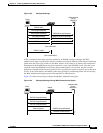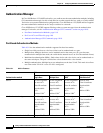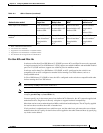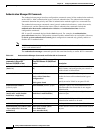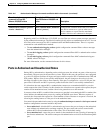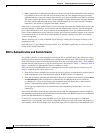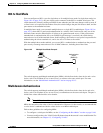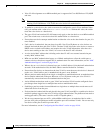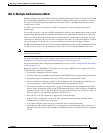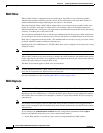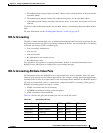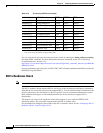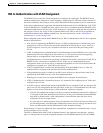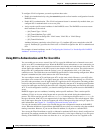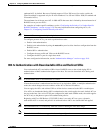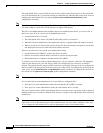
10-15
Catalyst 2960 and 2960-S Switch Software Configuration Guide
OL-8603-09
Chapter 10 Configuring IEEE 802.1x Port-Based Authentication
Understanding IEEE 802.1x Port-Based Authentication
802.1x Multiple Authentication Mode
Multiple-authentication (multiauth) mode allows multiple authenticated clients on the data VLAN. Each
host is individually authenticated. If a voice VLAN is configured, this mode also allows one client on
the VLAN. (If the port detects any additional voice clients, they are discarded from the port, but no
violation errors occur.)
If a hub or access point is connected to an 802.1x-enabled port, each connected client must be
authenticated.
For non-802.1x devices, you can use MAC authentication bypass or web authentication as the per-host
authentication fallback method to authenticate different hosts with different methods on a single port.
There is no limit to the number of data hosts can authenticate on a multiauthport. However, only one
voice device is allowed if the voice VLAN is configured. Since there is no host limit defined violation
will not be trigger, if a second voice is seen we silently discard it but do not trigger violation.
For MDA functionality on the voice VLAN, multiple-authentication mode assigns authenticated devices
to either a data or a voice VLAN, depending on the VSAs received from the authentication server.
Note When a port is in multiple-authentication mode, the guest VLAN and the authentication-failed VLAN
features do not activate.
For more information about critical authentication mode and the critical VLAN, see the “802.1x
Authentication with Inaccessible Authentication Bypass” section on page 10-26.
For more information about configuring multiauth mode on a port, see the “Configuring the Host Mode”
section on page 10-46.
Beginning with Cisco IOS Release 12.2(55)SE, you can assign a RADIUS-server-supplied VLAN in
multi-auth mode, under these conditions:
• The switch is running the LAN base image.
• The host is the first host authorized on the port, and the RADIUS server supplies VLAN information.
• Subsequent hosts are authorized with a VLAN that matches the operational VLAN.
• A host is authorized on the port with no VLAN assignment, and subsequent hosts either have no
VLAN assignment, or their VLAN information matches the operational VLAN.
• The first host authorized on the port has a group VLAN assignment, and subsequent hosts either
have no VLAN assignment, or their group VLAN matches the group VLAN on the port. Subsequent
hosts must use the same VLAN from the VLAN group as the first host. If a VLAN list is used, all
hosts are subject to the conditions specified in the VLAN list.
• Only one voice VLAN assignment is supported on a multi-auth port.
• After a VLAN is assigned to a host on the port, subsequent hosts must have matching VLAN
information or be denied access to the port.
• You cannot configure a guest VLAN or an auth-fail VLAN in multi-auth mode.
• The behavior of the critical-auth VLAN is not changed for multi-auth mode. When a host tries to
authenticate and the server is not reachable, all authorized hosts are reinitialized in the configured
VLAN.



